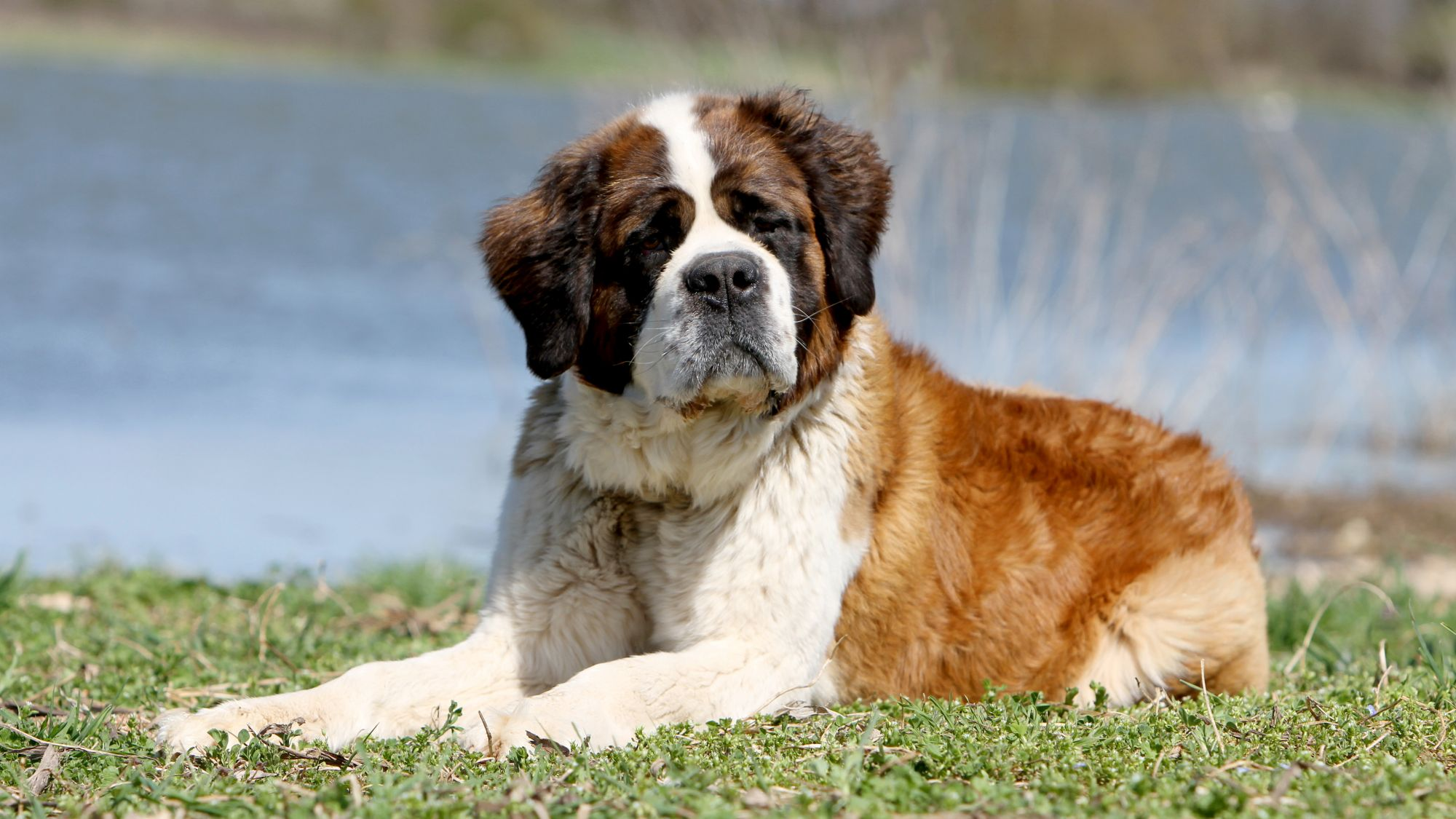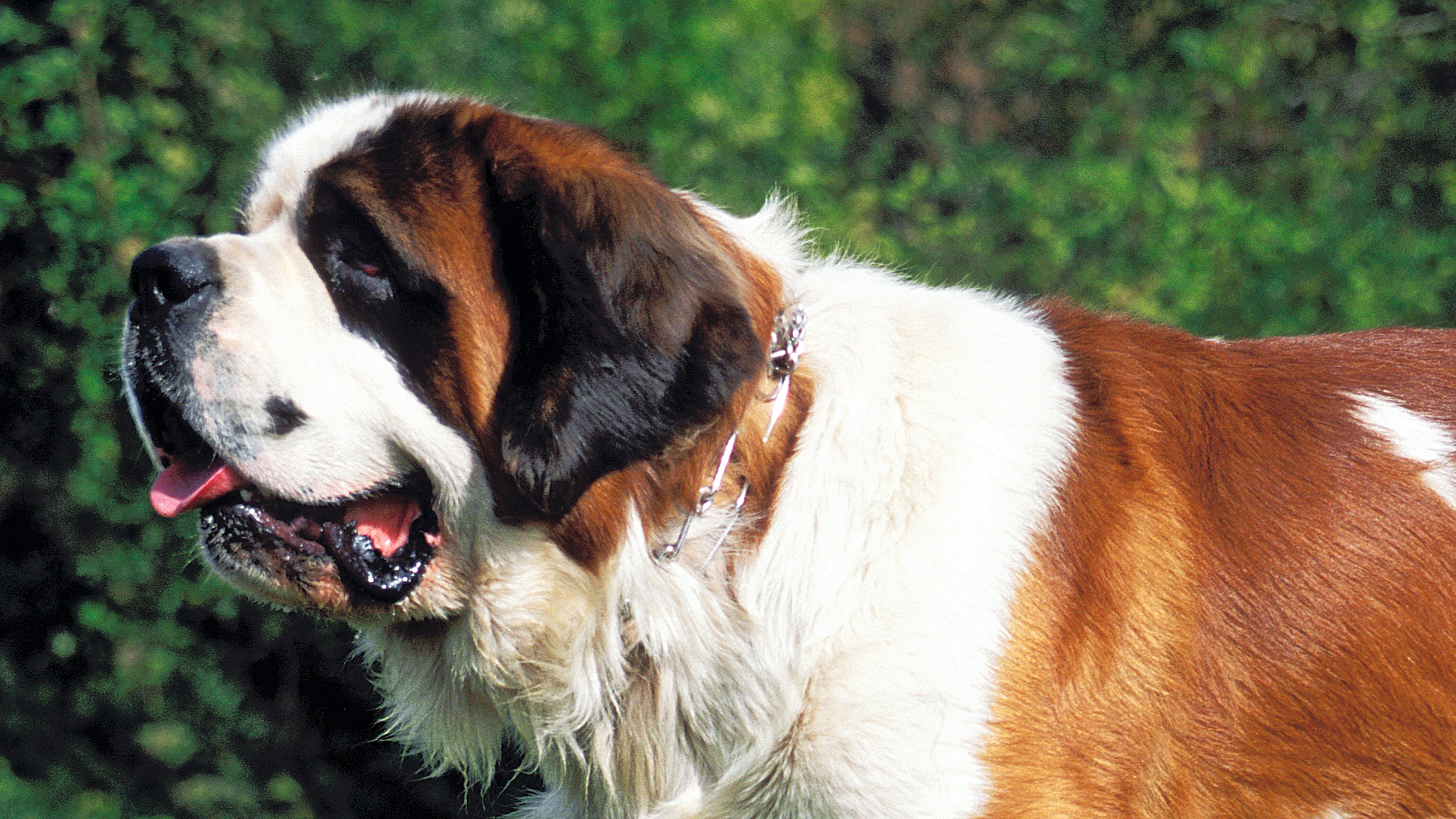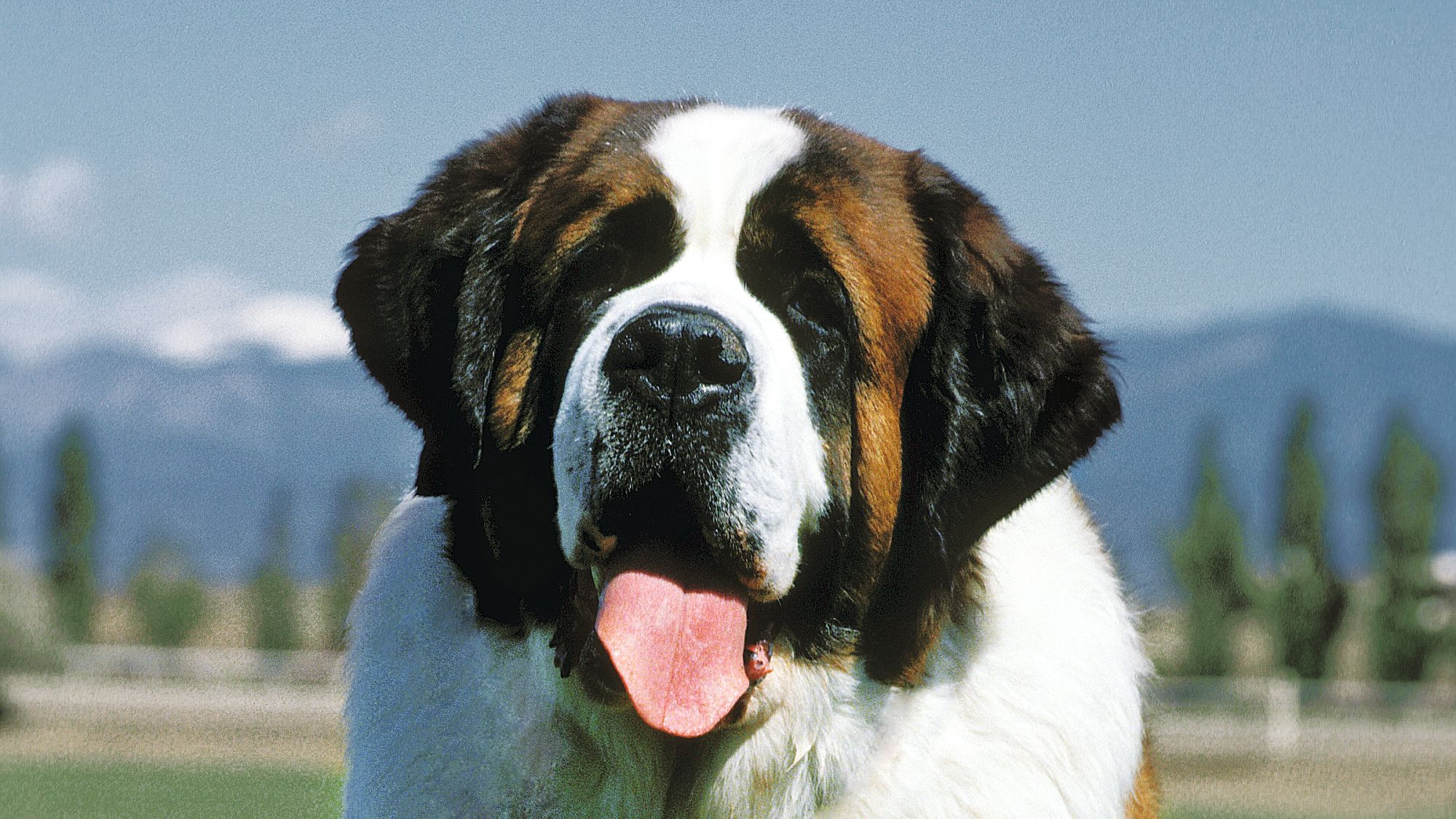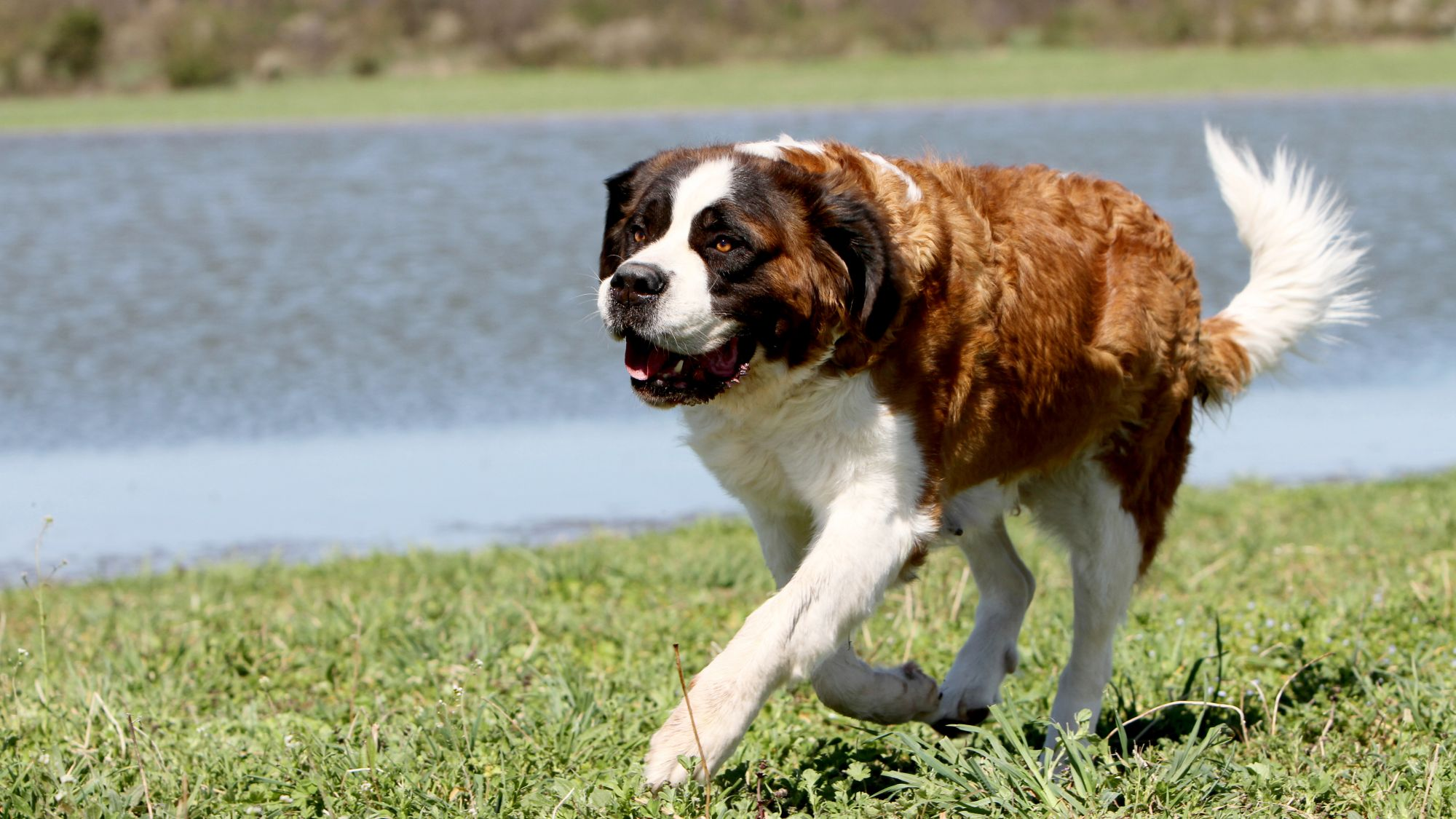Let's talk Saint Bernards
Their impressive size could make anyone think twice before approaching. But while the Saint Bernard may be all bulk on the outside, they’re all sweetness on the inside. The mellow, naturally friendly Saint Bernard originated in Switzerland where, for centuries, they worked as search and rescue dogs. Now retired from their illustrious careers as lifesavers, Saint Bernards are appreciated for their kind-hearted disposition and adaptability to urban life. If size and shedding aren’t issues, the Saint Bernard can make a wonderful addition to any family.
Official name: Saint Bernard
Other names: St.Bernhardshund, Bernhardiner
Origins: Switzerland
Drooling tendencies
5 out of 5Shedding Level
5 out of 5Energy level*
3 out of 5Compatibility with other pets
5 out of 5Warm weather?
1 out of 5Suited to apartment living
3 out of 5Family pet?*
5 out of 5Can stay alone
1 out of 5
| Male | Female |
|---|---|
| Height | Height |
| 68 - 76 cm | 66 - 71 cm |
| Weight | Weight |
| 63 - 82 kg | 54 - 64 kg |
| Life stages | |
|---|---|
| Adult | |
| 2 to 5 years | |
| Mature | Senior |
| 5 to 8 years | From 8 years |
| Baby | Junior |
| Birth to 2 months | 8 months to 2 years |
Drooling tendencies
5 out of 5Shedding Level
5 out of 5Energy level*
3 out of 5Compatibility with other pets
5 out of 5Warm weather?
1 out of 5Suited to apartment living
3 out of 5Family pet?*
5 out of 5Can stay alone
1 out of 5
| Male | Female |
|---|---|
| Height | Height |
| 68 - 76 cm | 66 - 71 cm |
| Weight | Weight |
| 63 - 82 kg | 54 - 64 kg |
| Life stages | |
|---|---|
| Adult | |
| 2 to 5 years | |
| Mature | Senior |
| 5 to 8 years | From 8 years |
| Baby | Junior |
| Birth to 2 months | 8 months to 2 years |

Get to know the Saint Bernard
All you need to know about the breed
Saint Bernards are a large, molosser type breed graced with a powerful, muscular build that makes for a formidable first impression. The Saint Bernard can grow to a height of 30 inches (76cm) and a whopping 180 pounds (82kg)—but don’t let their size distract you from their numerous other qualities. These gentle giants are renowned for their kind-hearted dispositions and the deep bond they form with their humans.
Generally quiet and easy-going, Saint Bernards prefer to be wherever their human families are and, as such, are quite well-suited to indoor living. However, because they do take up a bit of space, a Saint Bernard may not be the best choice for anyone living in a small apartment. And while a Saint Bernard will readily chill around the house, they do need to get out at least once a day for a good walk, and if there’s a garden where they can really spread out, even better.
It should also be said that anyone with a penchant for cleanliness might find living with a Saint Bernard somewhat challenging. Whether they’re the short or longhaired variety, Saint Bernards shed regularly and blow their coats twice yearly. Package that with jowls that predispose them to frequent drooling and a tendency to bring dirt and debris in from the outdoors, and you’ve got your work cut out. However, for those ready to invest a bit of time in obedience training and grooming, the resplendent Saint Bernard can offer highly rewarding companionship.

2 facts about Saint Bernards
1. Can I see some I.D.?
We’ve all seen pictures of a Saint Bernard sporting a mini keg and offering salvation to stranded travellers. But while Saint Bernards did carry containers of food and water to revive those they rescued, roving bartenders they were not. This myth originated with a 19th century painting by 17-year-old artist Edward Landseer entitled “Alpine Mastiffs Reanimating a Distressed Traveller” in which two Saint Bernards rescue a hiker. Landseer explained that the small barrel worn by one of the dogs was filled with brandy, and the story stuck.
2. Et tu ... Molosser?
Though the Saint Bernards we know and adore today are known to have come from Switzerland, their precise lineage remains a subject of speculation. It is widely believed that when the Roman army, under Emperor Augustus, invaded Helvetia – or modern-day Switzerland – they brought friends. Those friends? Large, mastiff-like war dogs known as molossers. Since battle wasn’t necessarily on the menu every day, the burly canines found other activities involving local mountain dogs to keep them occupied. And the result was very likely the beginning of the Saint Bernard line.
History of the breed
Around the year 1050, the Archdeacon Bernard de Menthon established a hospice on a treacherous pass in the Alps to offer relief to weary travellers. It’s likely that the hospice monks initially used local mountain dogs to guard the hospice grounds; but the dogs’ endurance, tracking skills and powerful sense of smell soon became of vital importance to the monks who regularly set out to find and rescue poor souls overcome by the often-harsh mountain conditions. According to records from the hospice, these hardy canines were credited with rescuing more than 2,000 people over three centuries. For years, the breed went by many names including Hospice Dog and Barryhund, in honour of Barry, the dog famed for saving 40 lives in the early 19th century. It wasn’t until 1880 that they were registered with the Swiss Kennel Club as the Saint Bernard Dog, after the suggestion was made that they be named after the famous mountain hospice.
Saint Bernards have since enjoyed solid popularity thanks to their steady temperament and warm hearts, and are cherished companions all over the world.
From head to tail
Physical characteristics of Saint Bernards
1.Head
2.Eyes
3.Body
4.Coat
5.Tail

Things to look out for
From specific breed traits to a general health overview, here are some interesting facts about your Saint Bernard
The heart of it all
As is the case for many large breeds, Saint Bernards have been known to develop dilated cardiomyopathy, or DCM, a condition in which the heart muscle becomes thin and weak, making it difficult to pump blood to the body effectively. Signs of DCM can include extreme fatigue, fainting, and laboured breathing. It’s a good idea to have your Saint Bernard screened for any heart abnormalities. Your vet can then prescribe the course of action to make sure your dog lives their best life!
It isn’t so easy being big
Like many large dog breeds, the Saint Bernard is prone to several orthopaedic diseases, the most common of which is hip dysplasia. This is a hereditary condition wherein the ball and socket of the hip joint develop abnormally, causing them to rub and grind rather than slide smoothly. Over time, this can lead to osteoporosis and loss of joint function. While hip dysplasia is inherited, factors including an excessive growth rate, certain exercises, weight and nutritional issues can exacerbate the predisposition. Large breed puppies can benefit from specially-formulated food that helps slow down their growth rate, allowing the joints to develop under less strain. Additionally, responsible breeders screen their breeding stock to eliminate issues like hip dysplasia. However, should you notice a swaying gait – more commonly called “bunny hopping” – a decrease in range of movement, difficulty standing and/or lameness in one or both hind legs, be sure to see your vet immediately to get a diagnosis and appropriate treatment.
Healthy diet, healthier dog

When choosing food for a Saint Bernard, there are many factors to consider: Their age, lifestyle, activity level, physical condition, and health including potential sickness or sensitivities. Food provides energy to cover a dog’s vital functions, and a complete nutritional formula should contain an adjusted balance of nutrients to avoid any deficiency or excess in their diet, both of which could have adverse effects on the dog. As giant-sized breed dogs have a higher risk of a condition called gastric dilatation volvulus (GDV), where the stomach becomes overstretched and rotated because of excess gas (usually caused by overfeeding during a meal), it’s recommended to split the daily allowance into three meals for puppies and try to keep this routine into their adult years.
Clean and fresh water should be available at all times to support good urinary regularity. In hot weather and especially when out exercising, bring water along for your dog’s frequent water breaks. Energy intake may also have to be adapted to the climatic conditions. A dog that lives outdoors in winter will have increased energy requirements.
The following recommendations are for healthy animals. If your dog has health problems, please consult your veterinarian who will prescribe an exclusively veterinary diet.
A Saint Bernard puppy’s requirements, in terms of energy, protein, minerals and vitamins, are greater than those of an adult dog. They need energy and nutrients to maintain their body, but also to grow and build it. During their growth, a Saint Bernard puppy’s immune system develops gradually. A complex of antioxidants – including vitamin E – can help support their natural defences during this time of big changes, discoveries, and new encounters. Their digestive functions are different from those of an adult Saint Bernard, too: Their digestive system is not mature yet so it is important to provide highly-digestible proteins that will be effectively used for the building of bones, tissues, and organs. Prebiotics, such as fructo-oligosaccharides, can support digestive health by helping balance the intestinal flora, resulting in good stool.
Giant-sized puppies, whose growth period is long and intense, are especially susceptible to skeletal and joint problems, including limb defects, bone deformities, and joint lesions.
The first part of growth (up to 8 months) is mainly concerned with bone development, although the muscles also start to grow. This means that a puppy that eats too much (takes in too much energy) will put on too much weight and grow too quickly. A food with an adjusted calorie content to support a high growth rate while at the same time avoiding excess weight gain will help minimise these risks. A balance of energy and minerals (calcium and phosphorous) during this first phase of growth will contribute to bone mineralisation in order to support bone consolidation and the development of healthy joints. Although the calcium content in the food needs to be increased, giant-sized breed puppies are more sensitive to excessive calcium intake. It’s important to understand that adding any ingredients to a complete food formulated for the growth phase is at best unnecessary and at worst dangerous for the animal, unless prescribed by a veterinarian.

As many giant-sized breed dogs, Saint Bernards are prone to digestive sensitivity, and their body weight can create stress on their joints throughout their lifetime. Saint Bernards’ nutritional needs then should include high-quality protein and a balanced supply of dietary fibre to help promote optimal digestibility, as well as glucosamine, chondroitine, and antioxidants to help support the health of their bones and joints. A formula enriched with omega-3 fatty acids, such as EPA and DHA, will help maintain healthy skin. An adapted taurine content is also important to support healthy heart function.
It is important to avoid feeding Saint Bernards human foods or fatty snacks. Instead, reward them with kibble taken from their daily meal allowance, and strictly follow the feeding guidelines written on the package.
Clean and fresh water should be available at all times. In hot weather and especially when out exercising, bring water along for your dog’s frequent water breaks.

Caring for your Saint Bernard
Grooming, training and exercise tips
Whether short or long-haired, your Saint Bernard should be brushed three times a week to remove any dirt or loose hair, and daily during biannual shedding seasons. Also, remember to brush your Saint Bernard’s teeth two to three times a week, and trim nails once or twice a month to ensure their maximum comfort.
While not avid joggers, the Saint Bernard does need a moderate amount of exercise. A nice daily walk and half an hour of outdoor play, provided it isn’t too warm, should keep your dog in peak form.
For dogs as large as the Saint Bernard, early training and socialisation are key to teaching them not to jump on people, bump into smaller children, or any other behaviours where their size is definitely a factor. Intelligent and generally eager to please, well-trained Saint Bernards will respond to learned commands and excel in competition and obedience trials.
7/7
All about Saint Bernards
Saint Bernards are not known to be particularly aggressive. However, they do tend to be very protective of their human families and may bark if they suspect their loved ones are in danger. Luckily, their size is usually enough to ward off any threat.
Although Saint Bernards can sometimes display a bit of a stubborn streak, the breed is usually eager to please and responds very well to motivation training methods. And as always, the earlier training starts, the more satisfying the results.
Suggested Breeds
Read more on this topic
- Veterinary Centers of America https://vcahospitals.com/;
- Royal Canin Dog Encyclopaedia. Ed 2010 and 2020
- Banfield Pet Hospital https://www.banfield.com/
- Royal Canin BHN Product Book
- American Kennel Club https://www.akc.org/
Like & share this page